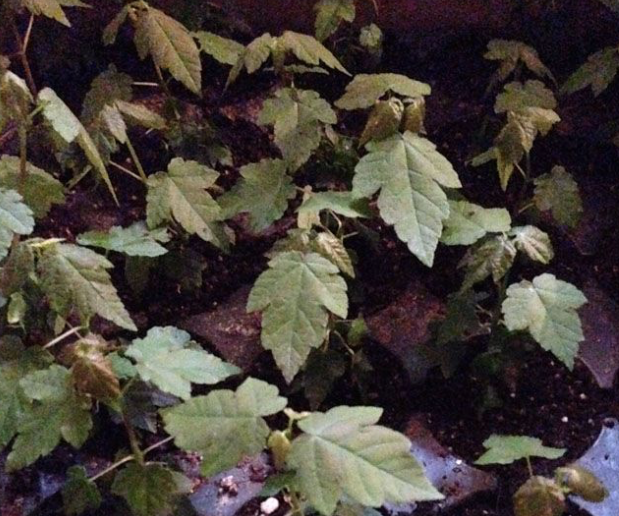Plant iron wilt yellow disease what is the relationship between plant leaf greening and iron? What is the effect of iron on plants?
Iron yellowing can affect many kinds of plants and can be frustrating for gardeners. Iron deficiency in plants leads to ugly yellow leaves and eventually death. Therefore, it is important to correct the yellowing of iron in plants. Let's take a look at the effect of iron on plants and how to solve systemic yellowing in plants.
What effect does iron have on plants? Iron is a nutrient that all plants need to operate. Many important functions of plants, such as enzyme and chlorophyll production, nitrogen fixation, development and metabolism, are dependent on iron. Without iron, plants cannot function properly at all. Symptoms of iron deficiency in plants the most obvious symptom of iron deficiency in plants is often called leaf wilt. This is where the leaves of the plant turn yellow, but the veins of the leaves remain green. Usually, leaf wilt will start at the tip of the new growth of the plant, and as the defect aggravates, it will eventually have an effect on the old leaves of the plant. Other signs may include poor growth and loss of leaves, but these symptoms will always be combined with leaf wilt.
Iron yellowing in plants is rarely due to iron deficiency in the soil. Iron is usually rich in soil, but various soil conditions limit the extent to which plants can get iron in the soil. Iron yellowing in plants is usually caused by one of four reasons.
They are: soil pH is too high soil contains too much clay compacted or over-wet soil, soil has too much phosphorus, fixed soil pH is too high to test soil in your local extension service. If the soil pH value exceeds 7, the soil pH value limits the ability of plants to obtain iron from the soil. You can learn more about reducing soil pH in this article. Correct the soil content too much clay soil lack of organic matter. The lack of organic matter is actually the reason why plants are unable to obtain iron from clay. Plants need micronutrients in organic matter to bring iron into their roots.
If clay causes iron yellowing, correcting plant iron deficiency means soil fattening in organic matter such as peat moss and compost. Improve compacted or over-wet soil if the soil is compacted or too wet, there is not enough air in the roots to properly absorb enough iron for plants.
If the soil is too wet, it is necessary to improve its drainage. If the soil is compacted, it is usually difficult to reverse it, so other methods are usually used to add iron to the plant. If you cannot correct drainage or reverse compaction, iron chelate can be used as a foliar spray or soil supplement. This will further increase the amount of iron available to plants and counteract the weakening ability of plants to absorb iron through their roots. Reducing the amount of phosphorus in the soil and excessive phosphorus will hinder the absorption of iron by plants, resulting in yellowing leaves. Usually, this is caused by the use of fertilizers with too much phosphorus. Use fertilizers with low phosphorus content (middle number) to help restore soil balance.

- Prev

Loss of 3.6 million hectares of virgin forest in 2018 for economic commodities such as beef and palm oil
According to satellite analysis by the World Resources Institute (World Resources Institute) of the Global Forest Watch Network (GFW), millions of hectares of pristine rainforest were destroyed in 2018, mainly due to beef, chocolate and palm oil, the Guardian reported.
- Next

Introduction to the planting methods and growth conditions of Swiss sugar beet, and how to sow and plant Swiss sugar beet.
Swiss beet is easy to grow, which makes it an ideal choice for beginner gardeners, who are looking for an effortless crop. Beets have wide, thick stems and are available in a variety of colors: bright white, yellowish, and even lipstick pink!
Related
- A course of planting techniques and methods on how to grow carrots
- How to plant the latest tulips?
- Is it better to pick tea in the morning or in the afternoon? When is the best time for tea to be picked? what is the third or fifth tea?
- Launch Yuanxiao Happy combination Haocha + Tea Yuan healthy Taste
- Penghu Tourism "Fireworks 20 Parade with You"
- 2022 West Lake Happiness holds "Digital Revitalization Voucher" and draws iphone13 and laptop.
- Banqiao Fuzhou social houses are designed to change start-up combined with police elimination to create a safe and livable environment
- The convenient measure of "mechanical weeding" in Xinbei has been abused and the Agriculture Bureau has imposed heavy penalties on the illegal land consolidation.
- Changgeng University Joins Hands with Four Memory Factories to Rescue Memory Talent Shortage
- The list of Taiwan's top 100 MVP managers is listed by the Director-General of the Farmers' Association of Sanxia District.

